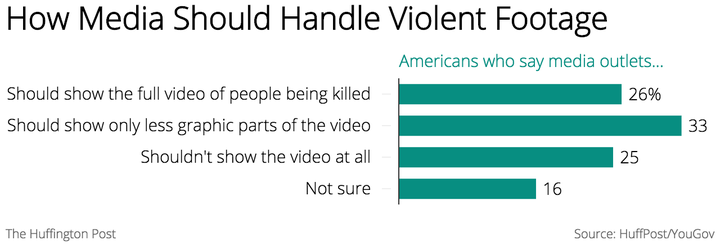Media outlets have long debated how best to deal with violent video footage -- a topic that resurfaced tragically last week after the fatal shooting of two journalists on live television.
Different news organizations came to different conclusions. CNN warned viewers before playing footage of the shooting, while other outlets, including The Huffington Post, stopped the video before shots were fired, or chose not to use audio from attack. WDBJ, where the victims worked, chose not to rebroadcast any of the video.
“It’s not a decision you make lightly," Al Ortiz, CBS' vice president of standards and practices, told the AP. "An argument was made that we were doing the gunman’s work for him. But the decision we came around to was that it was editorially important to show how methodical, planned and deliberate this was. That’s the only reason we used it.”
Nearly half of Americans ended up seeing at least some footage of the incident, thanks in part to autoplaying videos on Twitter. In a HuffPost/YouGov poll taken days after the shooting, 88 percent of Americans said they'd heard about the story, and 49 percent that they'd seen at least some of the video. A quarter said they'd watched the actual shooting itself.
The public is also divided on how the media should report on videos that show people being killed. About a quarter of Americans thought media outlets should show the full video, while another 25 percent said videos showing people being killed shouldn't be aired at all. A third staked out a middle position, saying outlets should only show the less graphic parts of a video.

Most Americans have less tolerance, though, for seeing videos of fatal incidents popping up on social media, where the shooter posted footage of the killings before his accounts were quickly deleted. A 51 percent majority said sites like Twitter and Facebook should delete videos that show people being killed, while just 26 percent said such videos should be allowed to stay up.

A 53 percent majority of Americans say that it's disrespectful to victims to watch the videos of them being killed, similar to the 51 percent who said earlier this year that it's disrespectful specifically to watch videos showing Islamic State militants beheading hostages. Just 27 percent said it wasn't disrespectful, with the remainder unsure.
Opinions are divided both along gender and generational lines, with men and younger Americans more likely than women and older Americans to say the videos should be shown by news organizations, or allowed to stay up on social media.
The HuffPost/YouGov poll consisted of 1,000 completed interviews conducted Aug. 27-31 among U.S. adults, using a sample selected from YouGov's opt-in online panel to match the demographics and other characteristics of the adult U.S. population.
The Huffington Post has teamed up with YouGov to conduct daily opinion polls. You can learn more about this project and take part in YouGov's nationally representative opinion polling. Data from all HuffPost/YouGov polls can be found here. More details on the polls' methodology are available here.
Most surveys report a margin of error that represents some, but not all, potential survey errors. YouGov's reports include a model-based margin of error, which rests on a specific set of statistical assumptions about the selected sample, rather than the standard methodology for random probability sampling. If these assumptions are wrong, the model-based margin of error may also be inaccurate. Click here for a more detailed explanation of the model-based margin of error.
